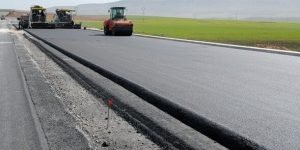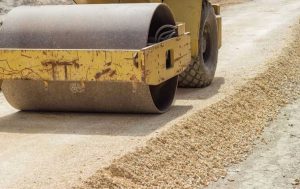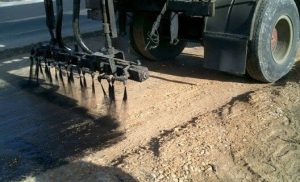What is Bitumen Road? its 6 Construction Steps, & Advantages
Bitumen road consists of its surface with bituminous materials and bitumen is a sticky dark viscous liquid obtained from natural deposits.
A bitumen road has a smooth surface to ride and also gives less sound emission and as compared to concrete pavement, the initial cost and overall maintenance cost of a bitumen road are less.

Due to various properties and advantages, bitumen is used in road construction and gains certain unique properties.
Construction of Bitumen Road:
There are various steps in the construction of bitumen roads as discussed below;
- Preparation of the existing base course layer
- Application of Tuck Coat
- Preparation and placing of Premix
- Rolling
- Quality control of bituminous concrete construction
- Finished Surface
Preparation of the existing base course layer:
By removing the potholes or rust, the existing surface is prepared and at least a week before laying the surface course the irregularities are filled in with premix chippings. To lay a bituminous concrete surface course on a binder course, a bituminous levelling course of adequate thickness is provided if the existing pavement is extremely way.

Application of Tuck Coat:
To lay an Asphalt Concrete layer over a bituminous base or binder course is desirable and at 6.0 kg to 7.5 kg per 10 sq.m areas, a tack coat of bitumen is applied. For the non-bituminous base, this quantity may be increased from 7.5 kg to 10 kg.

Preparation and placing of Premix:
In a hot mix plant of a required capacity with the desired quality control, the premix is prepared and the bitumen may be heated up to 150 to 177 degrees centigrade. By over 14 degrees centigrade from the binder temperature, the aggregate temperature should not differ.
By the transporters, the hot mixed material is collected from the mixture, and by a mechanical paver at a temperature of 121 to 163 degrees centigrade, it is carried to the location.

In the strength of the resulting pavement structure, the control of the temperatures during the mixing and the compaction is of great significance.
Rolling:
By rolling at a speed not more than 5km per hour, a mix after it is placed on the base course is thoroughly compacted, and by 8 to 12 tonnes roller the initial or break down rolling is done.
With a fixed wheel pneumatic roller of 15 to 30 tones having a tire pressure of 7kg per sq. cm, the intermediate rolling is done and with water, the wheels of the roller are kept damp.

The number of passes required depends on the thickness of the layer and in warm weather if the initial rolling was not adequate rolling on the next day helps to increase the density.
Quality control of bituminous concrete construction:
To ensure the quality of the resulting pavement mixture and the pavement surface routine checks are carried out at the site and periodical checks are made for aggregate grading, the grade of bitumen, the temperature of aggregate, and the temperature of paving mix during mixing and compaction.

For these requirements, at least one sample for every 100 tones of the mix discharged by the hot mix plant is collected and tested. In the laboratory, one test of the field density is conducted to check whether it is at least 95% of the density obtained for every 100 sq.m of the compacted surface.
Finished Surface:
By a 3.0 m straight edge, the Asphalt Concrete surface should be checked and the number of undulations higher than 6.0 mm should not exceed 10 in a length of 300 m and the longitudinal undulations should not exceed 8.0 mm.

Advantages of Bitumen Road:
There are the following advantages of bitumen road as given below;
A smooth ride Surface:
It provides a smooth surface to ride because it does not make use of any joints and as compared with concrete pavements, it also gives less sound emission. It maintains smoothness because the wear and tear are less on the bitumen road.
Gradual Failure:
The concrete pavement shows brittle failures and the deformation and the failure is a gradual process in bitumen roads.
Quick Repair:
The repairing of bitumen roads is a quick process and they set fast so they don’t consume time in reverting the path for traffic.
Staged Construction:
In a situation when problems of fund constraints or traffic estimation problems are faced, this helps in carrying out staged construction.
Life Cost is less:
As compared to concrete pavement, the initial cost and overall maintenance cost of bituminous pavement are less.
Temperature Resistant:
They are not affected by de-icing materials and act resistant against high temperatures from melting.
Disadvantages of Bitumen Road:
There are also some disadvantages of bitumen roads such as;
- These are less durable and have low tensile strength.
- The bitumen road will be slick and soft in extreme weather and improper weather conditions.
- To soils, bitumen with impurities can cause pollution.
- During extreme conditions of temperature, the cost of construction is high.
